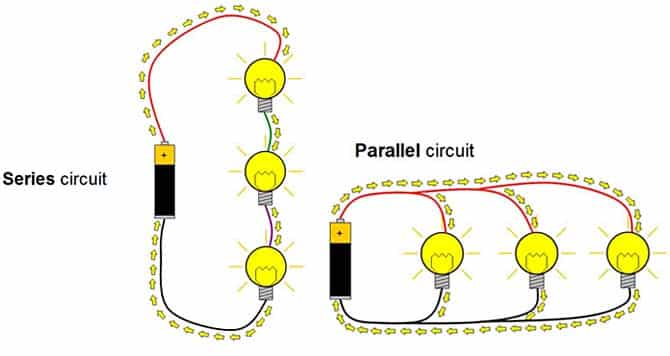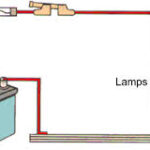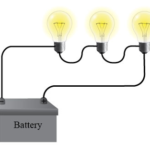When there are two or more electrical devices present in a circuit with an energy source, there are a couple of basic means by which to connect them. They can be connected in series or connected in parallel. Suppose that there are three light bulbs connected together in the same circuit. If connected in series, then they are connected in such a way that an individual charge would pass through each one of the light bulbs in consecutive fashion. When in series, charge passes through every light bulb. If connected in parallel, a single charge passing through the external circuit would only pass through one of the light bulbs. The light bulbs are placed within a separate branch line, and a charge traversing the external circuit will pass through only one of the branches during its path back to the low potential terminal. The means by which the resistors are connected will have a major effect upon the overall resistance of the circuit, the total current in the circuit, and the current in each resistor. In Lesson 4, we will explore the effect of the type of connection upon the overall current and resistance of the circuit.
A common physics lab activity involves constructing both types of circuits with bulbs connected in series and bulbs connected in parallel. A comparison and contrast is made between the two circuits.

The main questions of concern in a lab activity such as this are typically the following:
· As the number of resistors (light bulbs) increases, what happens to the overall current within the circuit?
· As the number of resistors (light bulbs) increases, what happens to the overall resistance within the circuit?
· If one of the resistors is turned off (i.e., a light bulb goes out), what happens to the other resistors (light bulbs) in the circuit? Do they remain on (i.e., lit)?
Exploring Series Connections
In conducting the lab activity, distinctly different observations are made for the two types of circuits. A series circuit can be constructed by connecting light bulbs in such a manner that there is a single pathway for charge flow; the bulbs are added to the same line with no branching point. As more and more light bulbs are added, the brightness of each bulb gradually decreases. This observation is an indicator that the current within the circuit is decreasing.

So for series circuits, as more resistors are added the overall  current within the circuit decreases. This decrease in current is consistent with the conclusion that the overall resistance increases.
current within the circuit decreases. This decrease in current is consistent with the conclusion that the overall resistance increases.
A final observation that is unique to series circuits is the effect of removing a bulb from a socket. If one of three bulbs in a series circuit is unscrewed from its socket, then it is observed that the other bulbs immediately go out. In order for the devices in a series circuit to work, each device must work. If one goes out, they all go out. Suppose that all the appliances in a household kitchen were all connected in series. In order for the refrigerator to work in that kitchen, the toaster oven, dishwasher, garbage disposal and overhead light would all have to be on. In order for one device in series to work, they all must work. If current is cut from any one of them, it is cut from all of them. Quite obviously, the appliances in the kitchen are not connected in series.
Exploring Parallel Connections
Using the same collection of wires, D-cells and bulbs, parallel circuits can be explored in the same manner. The effect of the number of resistors upon the overall current and the overall resistance can be investigated. The diagrams below depict the usual means of constructing the circuit with parallel connections of light bulbs. One will note that a study of the overall current for parallel connections requires the addition of an indicator bulb. The indicator bulb is placed outside of the branches and allows one to observe the effect of additional resistors upon the overall current. The bulbs that are placed in the parallel branches only provide an indicator of the current through that particular branch. So if investigating the effect of the number of resistors upon the overall current and resistance, one must make careful observations of the indicator bulb, not the bulbs that are placed in the branches. The diagram below depicts the typical observations.

It is clear from observing the indicator bulbs in the above diagrams that the addition of more resistors causes the indicator bulb to get brighter. For parallel circuits, as the number of resistors increases, the overall current also increases. This increase in current is consistent with a decrease in overall resistance. Adding more resistors in a separate branch has the unexpected result of decreasing the overall resistance!
 If an individual bulb in a parallel branch is unscrewed from its socket, then there is still current in the overall circuit and current in the other branches. Removing the third bulb from its socket has the effect of transforming the circuit from a three-bulb parallel circuit to a two-bulb parallel circuit. If the appliances in a household kitchen were connected in parallel, then the refrigerator could function without having to have the dishwasher, toaster, garbage disposal and overhead lights on. One appliance can work without the other appliances having to be on. Since each appliance is in its own separate branch, turning that appliance off merely cuts off the flow of charge to that branch. There will still be charge flowing through the other branches to the other appliances. Quite obviously, the appliances in a home are wired with parallel connections.
If an individual bulb in a parallel branch is unscrewed from its socket, then there is still current in the overall circuit and current in the other branches. Removing the third bulb from its socket has the effect of transforming the circuit from a three-bulb parallel circuit to a two-bulb parallel circuit. If the appliances in a household kitchen were connected in parallel, then the refrigerator could function without having to have the dishwasher, toaster, garbage disposal and overhead lights on. One appliance can work without the other appliances having to be on. Since each appliance is in its own separate branch, turning that appliance off merely cuts off the flow of charge to that branch. There will still be charge flowing through the other branches to the other appliances. Quite obviously, the appliances in a home are wired with parallel connections.
The Tollbooth Analogy
The effect of adding resistors is quite different if added in parallel compared to adding them in series. Adding more resistors in series means that there is more overall resistance; yet adding more resistors in parallel means that there is less overall resistance. The fact that one can add more resistors in parallel and produce less resistance is quite bothersome to many. An analogy may help to clarify the reason behind this initially bothersome truth.
The flow of charge through the wires of a circuit can be compared to the flow of cars along a tollway system in a very crowded metropolitan area. The main sources of resistance on a tollway system are the tollbooths. Stopping cars and forcing them to pay a toll at a tollbooth not only slows the cars down, but in a highly trafficked area, will also cause a bottleneck with a backup for miles. The rate at which cars flow past a point on that tollway system is reduced significantly by the presence of a tollbooth. Clearly, tollbooths are the main resistor to car flow.
Now suppose that in an effort to increase the flow rate the Tollway Authority decides to add two more tollbooths at a particular toll station where the bottleneck is troublesome to travelers. They consider two possible means of connecting their tollbooths – in series versus in parallel. If adding the tollbooths (i.e., resistors) in series, they would add them in a manner that every car flowing along the highway would have to stop at each tollbooth in consecutive fashion. With only one pathway through the tollbooths, each car would have to stop and pay a toll at each booth. Instead of paying 60 cents one time at one booth, they would now have to pay 20 cents three times at each of the three tollbooths. Quite obviously, adding tollbooths in series would have the overall effect of increasing the total amount of resistance and decreasing the overall car flow rate (i.e., current).
The other means of adding the two additional tollbooths at this particular toll station would be to add the tollbooths in parallel fashion. Each tollbooth could be placed in a separate branch. Cars flowing along the tollway would stop at only one of the three booths. There would be three possible pathways for cars to flow through the toll station and each car would chose only one of the pathways. Quite obviously, adding tollbooths in parallel would have the overall effect of decreasing the total amount of resistance and increasing the overall car flow rate (i.e., current) along the tollway. Just as is the case for adding more electrical resistors in parallel, adding more tollbooths in parallel branches creates less overall resistance. By allowing for more pathways (i.e., branches) by which charge and cars can flow through the bottleneck areas, the flow rate can be increased.

Check Your Understanding
1. Observe the electrical wiring below. Indicate whether the connections are series or parallel connections. Explain each choice.

See Answer

Diagram A: Parallel
There is a branching location in the circuit that allows for more than one pathway by which charge can flow through the external circuit.
Diagram B: Series
There is no branching in the circuit – that is, no location where one wire leads into a point and branches off into two or more wires at that particular point.
2. Two electric circuits are diagrammed below. For each circuit, indicate which two devices are connected in series and which two devices are connected in parallel.
 | |
| In series? ___________________In parallel? _________________ | In series? ___________________In parallel? _________________ |
See Answer

Diagram A:
Ammeter and Resistor are in series
Speaker and Bulb are in parallel (in separate branches)
Diagram B:
Ammeter and Speaker are in series
Resistor and Bulb are in parallel (in separate branches)


